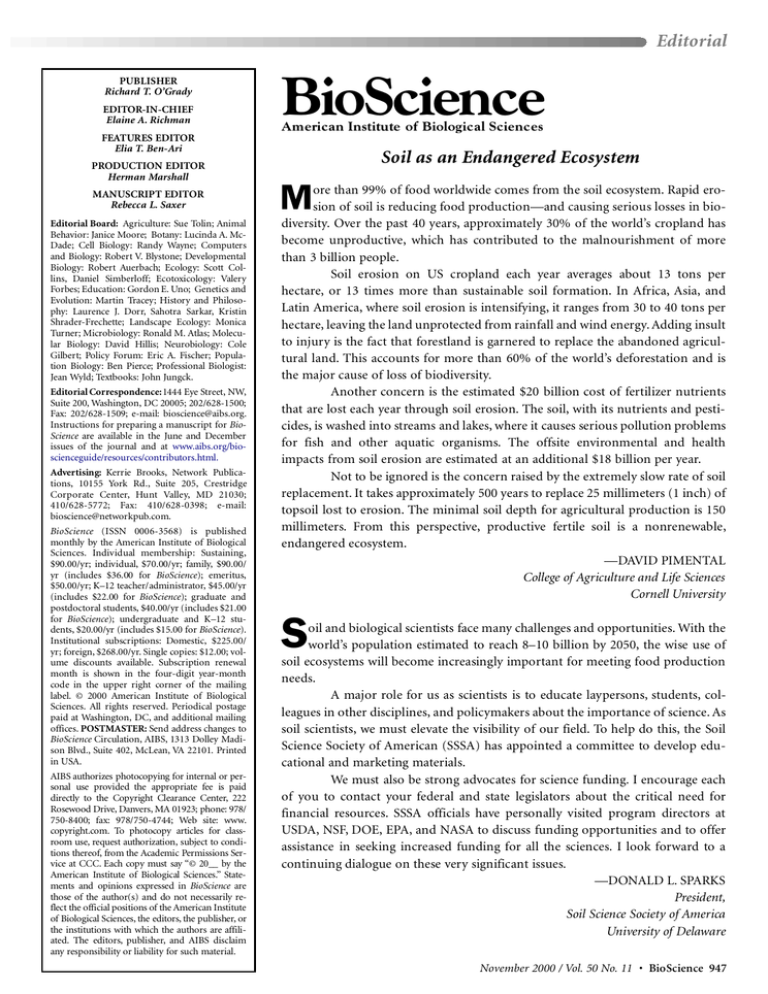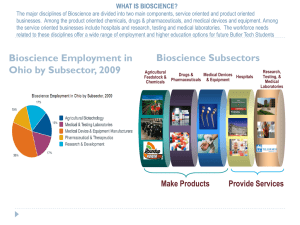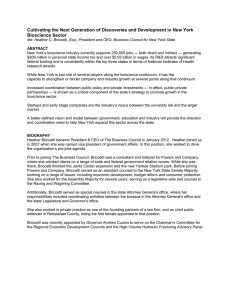
Editorial
PUBLISHER
Richard T. O’Grady
EDITOR-IN-CHIEF
Elaine A. Richman
FEATURES EDITOR
Elia T. Ben-Ari
PRODUCTION EDITOR
Herman Marshall
MANUSCRIPT EDITOR
Rebecca L. Saxer
Editorial Board: Agriculture: Sue Tolin; Animal
Behavior: Janice Moore; Botany: Lucinda A. McDade; Cell Biology: Randy Wayne; Computers
and Biology: Robert V. Blystone; Developmental
Biology: Robert Auerbach; Ecology: Scott Collins, Daniel Simberloff; Ecotoxicology: Valery
Forbes; Education: Gordon E. Uno; Genetics and
Evolution: Martin Tracey; History and Philosophy: Laurence J. Dorr, Sahotra Sarkar, Kristin
Shrader-Frechette; Landscape Ecology: Monica
Turner; Microbiology: Ronald M. Atlas; Molecular Biology: David Hillis; Neurobiology: Cole
Gilbert; Policy Forum: Eric A. Fischer; Population Biology: Ben Pierce; Professional Biologist:
Jean Wyld; Textbooks: John Jungck.
Editorial Correspondence:1444 Eye Street, NW,
Suite 200, Washington, DC 20005; 202/628-1500;
Fax: 202/628-1509; e-mail: bioscience@aibs.org.
Instructions for preparing a manuscript for BioScience are available in the June and December
issues of the journal and at www.aibs.org/bioscienceguide/resources/contributors.html.
Advertising: Kerrie Brooks, Network Publications, 10155 York Rd., Suite 205, Crestridge
Corporate Center, Hunt Valley, MD 21030;
410/628-5772; Fax: 410/628-0398; e-mail:
bioscience@networkpub.com.
BioScience (ISSN 0006-3568) is published
monthly by the American Institute of Biological
Sciences. Individual membership: Sustaining,
$90.00/yr; individual, $70.00/yr; family, $90.00/
yr (includes $36.00 for BioScience); emeritus,
$50.00/yr; K–12 teacher/administrator, $45.00/yr
(includes $22.00 for BioScience); graduate and
postdoctoral students, $40.00/yr (includes $21.00
for BioScience); undergraduate and K–12 students, $20.00/yr (includes $15.00 for BioScience).
Institutional subscriptions: Domestic, $225.00/
yr; foreign, $268.00/yr. Single copies: $12.00; volume discounts available. Subscription renewal
month is shown in the four-digit year-month
code in the upper right corner of the mailing
label. © 2000 American Institute of Biological
Sciences. All rights reserved. Periodical postage
paid at Washington, DC, and additional mailing
offices. POSTMASTER: Send address changes to
BioScience Circulation, AIBS, 1313 Dolley Madison Blvd., Suite 402, McLean, VA 22101. Printed
in USA.
AIBS authorizes photocopying for internal or personal use provided the appropriate fee is paid
directly to the Copyright Clearance Center, 222
Rosewood Drive, Danvers, MA 01923; phone: 978/
750-8400; fax: 978/750-4744; Web site: www.
copyright.com. To photocopy articles for classroom use, request authorization, subject to conditions thereof, from the Academic Permissions Service at CCC. Each copy must say “© 20__ by the
American Institute of Biological Sciences.” Statements and opinions expressed in BioScience are
those of the author(s) and do not necessarily reflect the official positions of the American Institute
of Biological Sciences, the editors, the publisher, or
the institutions with which the authors are affiliated. The editors, publisher, and AIBS disclaim
any responsibility or liability for such material.
BioScience
American Institute of Biological Sciences
Soil as an Endangered Ecosystem
M
ore than 99% of food worldwide comes from the soil ecosystem. Rapid erosion of soil is reducing food production—and causing serious losses in biodiversity. Over the past 40 years, approximately 30% of the world’s cropland has
become unproductive, which has contributed to the malnourishment of more
than 3 billion people.
Soil erosion on US cropland each year averages about 13 tons per
hectare, or 13 times more than sustainable soil formation. In Africa, Asia, and
Latin America, where soil erosion is intensifying, it ranges from 30 to 40 tons per
hectare, leaving the land unprotected from rainfall and wind energy. Adding insult
to injury is the fact that forestland is garnered to replace the abandoned agricultural land. This accounts for more than 60% of the world’s deforestation and is
the major cause of loss of biodiversity.
Another concern is the estimated $20 billion cost of fertilizer nutrients
that are lost each year through soil erosion. The soil, with its nutrients and pesticides, is washed into streams and lakes, where it causes serious pollution problems
for fish and other aquatic organisms. The offsite environmental and health
impacts from soil erosion are estimated at an additional $18 billion per year.
Not to be ignored is the concern raised by the extremely slow rate of soil
replacement. It takes approximately 500 years to replace 25 millimeters (1 inch) of
topsoil lost to erosion. The minimal soil depth for agricultural production is 150
millimeters. From this perspective, productive fertile soil is a nonrenewable,
endangered ecosystem.
—DAVID PIMENTAL
College of Agriculture and Life Sciences
Cornell University
S
oil and biological scientists face many challenges and opportunities. With the
world’s population estimated to reach 8–10 billion by 2050, the wise use of
soil ecosystems will become increasingly important for meeting food production
needs.
A major role for us as scientists is to educate laypersons, students, colleagues in other disciplines, and policymakers about the importance of science. As
soil scientists, we must elevate the visibility of our field. To help do this, the Soil
Science Society of American (SSSA) has appointed a committee to develop educational and marketing materials.
We must also be strong advocates for science funding. I encourage each
of you to contact your federal and state legislators about the critical need for
financial resources. SSSA officials have personally visited program directors at
USDA, NSF, DOE, EPA, and NASA to discuss funding opportunities and to offer
assistance in seeking increased funding for all the sciences. I look forward to a
continuing dialogue on these very significant issues.
—DONALD L. SPARKS
President,
Soil Science Society of America
University of Delaware
November 2000 / Vol. 50 No. 11 BioScience 947







